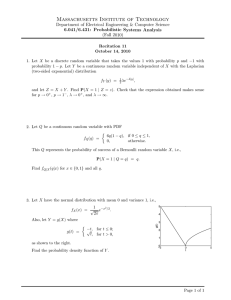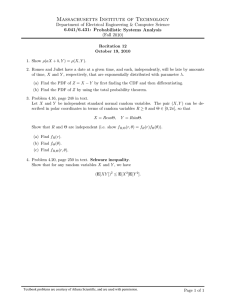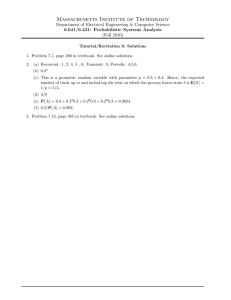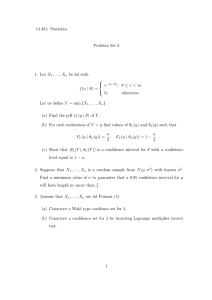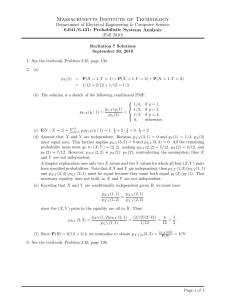Massachusetts Institute of Technology
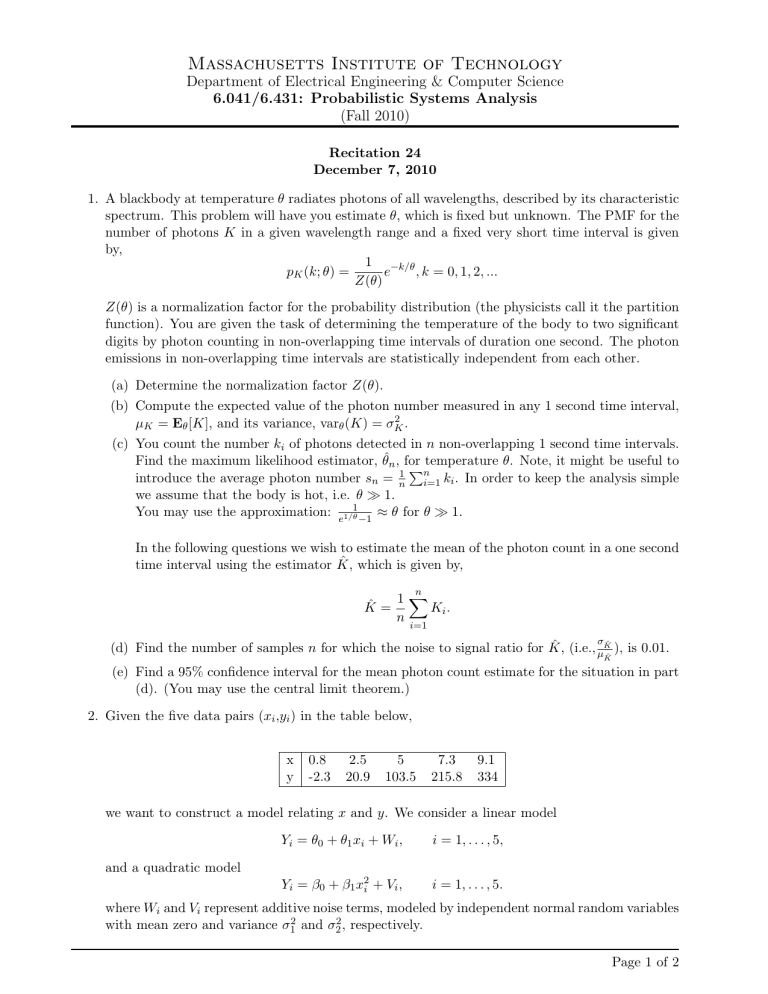
Massachusetts Institute of Technology
Department of Electrical Engineering & Computer Science
6.041/6.431: Probabilistic Systems Analysis
(Fall 2010)
Recitation 24
December 7, 2010
1. A blackbody at temperature θ radiates photons of all wavelengths, described by its characteristic spectrum. This problem will have you estimate θ , which is fixed but unknown. The PMF for the number of photons K in a given wavelength range and a fixed very short time interval is given by, p
K
( k ; θ ) =
1
Z ( θ ) e − k/θ
, k = 0 , 1 , 2 , ...
Z ( θ ) is a normalization factor for the probability distribution (the physicists call it the partition function). You are given the task of determining the temperature of the body to two significant digits by photon counting in non-overlapping time intervals of duration one second. The photon emissions in non-overlapping time intervals are statistically independent from each other.
(a) Determine the normalization factor Z ( θ ).
(b) Compute the expected value of the photon number measured in any 1 second time interval,
µ
K
= E
θ
[ K ], and its variance, var
θ
( K ) = σ
2
K
.
(c) You count the number k i of photons detected in n non-overlapping 1 second time intervals.
Find the maximum likelihood estimator, introduce the average photon number s n
θ n
, for temperature θ . Note, it might be useful to
= we assume that the body is hot, i.e. θ ≫
1.
1 n
� n i =1 k i
. In order to keep the analysis simple
You may use the approximation: 1 e 1 /θ
−
1
≈ θ for θ ≫
1.
In the following questions we wish to estimate the mean of the photon count in a one second time interval using the estimator K
1 n
�
K i
. i =1
(d) Find the number of samples n for which the noise to signal ratio for K
σ
µ
), is 0.01.
(e) Find a 95% confidence interval for the mean photon count estimate for the situation in part
(d). (You may use the central limit theorem.)
2. Given the five data pairs ( x i
, y i
) in the table below, x 0.8 2.5 5 7.3 9.1 y -2.3 20.9 103.5 215.8 334 we want to construct a model relating x and y . We consider a linear model
Y i
= θ
0
+ θ
1 x i
+ W i
, i = 1 , . . . , 5 , and a quadratic model
Y i
= β
0
+ β
1 x
2 i
+ V i
, i = 1 , . . . , 5 . where W i and V i represent additive noise terms, modeled by independent normal random variables with mean zero and variance σ
2
1 and σ
2
2
, respectively.
Page 1 of 2
Massachusetts Institute of Technology
Department of Electrical Engineering & Computer Science
6.041/6.431: Probabilistic Systems Analysis
(Fall 2010)
(a) Find the ML estimates of the linear model parameters.
(b) Find the ML estimates of the quadratic model parameters.
Note: You may use the regression formulas and the connection with ML described in pages
478-479 of the text. However, the regression material is outside the scope of the final.
The figure below shows the data points ( x i
, y i
), i = 1 , . . . , 5 , the estimated linear model y = 40 .
53 x −
65 .
86 , and the estimated quadratic model y = 4 .
09 x
2
−
3 .
07 .
500
400
Sample data points
300
Estimated first-order model
Y 200
100
Estimated second-order model
0
-100
0 2 4 6
X
8 10 12
Figure 1: Regression Plot
Image by MIT OpenCourseWare.
Page 2 of 2
MIT OpenCourseWare http://ocw.mit.edu
6.041SC Probabilistic Systems Analysis and Applied Probability
Fall 2013
For information about citing these materials or our Terms of Use, visit: http://ocw.mit.edu/terms .
